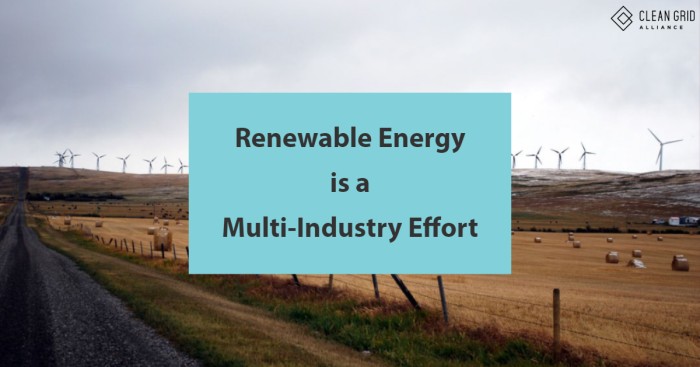Renewable Energy is a Multi-Industry Effort
 | Holly Fritz, Communications/Policy Associate |

 | Holly Fritz, Communications/Policy Associate |
There’s a lot to love about renewables. From being a low-cost source of electricity generation to a smart business venture, renewable energy has a lot to offer. As wind energy hits the 100 gigawatt (GW) mark, and with more megawatts (MW) in the pipeline, clean energy capacity will continue to increase. That means more jobs, economic benefits, and of course, a reliable energy source that powers millions of homes. This wouldn’t be possible, however, without partnering industries like manufacturing, shipping and ground transportation.
Maybe the Midwest isn’t the first place that comes to mind when you think of global shipping, but it is becoming an important location for wind cargo. Ports account for 26 percent of U.S. economic activity ($4.6 trillion). Minnesota is the seventh largest wind-producing state, and as the cost of wind decreased 67 percent in the last seven years, it has become an important part of the Great Lakes area cargo portfolio.
The Port of Duluth receives wind energy parts from Spain, Denmark, Germany, South Korea and China for transport to inland wind energy projects. As the farthest inland port in North America, Duluth is a stellar location to support wind farm installations in the Upper Midwest and central Canada, and it acts as an efficient connection between modes of transportation for manufacturers and wind customers. The Duluth port is the farthest western terminus of The Great Lakes-St. Lawrence Seaway system, a 2,300 mile-long US/Canadian marine highway that extends as far as the Atlantic. More than 160 million metric tons of cargo moves through this system every year. In 2019, Duluth received 306,000 freight tons of wind cargo through its gates, a record high.
Wind cargo doesn’t just come in from other countries. Wind turbine blades made in North Dakota are also shipped from Duluth to Spain, Brazil and Chile. These cargo shipments have positive economic impacts on state economies and offer great job opportunities. Another top shipping state is Michigan. It has more ports than any other state in the region; the state’s booming shipping economy employs 26,819 people as of 2018.
The Midwest wouldn’t be able to reap the benefits from renewables as easily – or economically – without its solid port and ground transportation infrastructures. This is essential to improving capabilities and drawing more imported bulk cargoes through ports. In addition, roads have to be kept up-to-date in order for vehicles to deliver wind parts to their final destination. The revenue that wind energy provides has actually been a big help in improving local infrastructure.
Wind farms provide new tax revenue for counties and townships, which is often used to improve roads, bridges and reduce taxes. Not only does this help entire communities, but it ensures farmers can continue operating heavy machinery on roads and bridges around their farm. It also provides manufacturers and heavy-haul trucking operations with optimal transportation routes for wind components to be delivered.
Maintaining solid infrastructures also requires support at the city, county, state and federal government levels. As the wind industry flourishes, this has become a priority to accommodate demand. In Minnesota, there are 15,187 bridges that are owned by counties, cities and local governments. Some of these bridges were built to meet design standards that are now outdated by 50 years or more, with narrow lanes and shoulders. Wind turbines are now an average of 62 meters long. The Minnesota Department of Transportation (MNDOT) and the Department of Natural Resources (DNR) have embraced innovation to ensure bridges meet modern-day standards for trucks and other transportation modes that meet weight and size capacities to get from Point A to Point B.
Overall, $121 million has been invested in Minnesota’s port, terminal and waterway infrastructure. The Port of Duluth’s docks C and D, located across from the Clure Public Marine Terminal at the end of Rice’s Point, recently completed a $25 million transformation into a multimodal transportation hub.
Renewable sources, like wind, are a great environmental solution to our growing need for energy. Renewable energy is now the second largest source of electricity in Minnesota, generating nearly 25 percent of the state’s electricity in 2017. Low-cost, clean, and reliable; renewable energy is just smart.